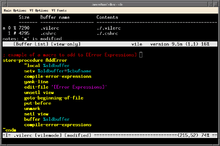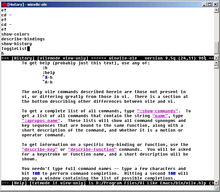vile (editor)
| Original author(s) | Paul Fox |
|---|---|
| Developer(s) | Thomas Dickey |
| Stable release |
9.8
/ August 7, 2010 |
| Operating system | Cross-platform |
| Type | Text editor |
| License | GNU General Public License |
| Website |
invisible-island |
vile is a text editor that attempts to combine the best aspects of the popular Emacs and vi editors. These editors are traditionally located on opposing sides of the editor wars, as users of Emacs and vi tend to have strong sentiments against the editor they do not use; however, vile at least attempts to reconcile these positions.
vile is an acronym which stands for "VI Like Emacs". vile is featured in Chapter 12 of the O'Reilly book "Learning the vi Editor".[1] The program is also known as xvile[2] for the X Window System, and as winvile for Microsoft Windows.
vile was created and originally maintained by Paul Fox. In 1996, maintenance was taken over by Thomas Dickey,[3] who had provided many major contributions to the codebase over the preceding years.
Learning to use vile


Historically, vile's documentation has focused on differences from vi. This is in contrast to the other common vi-clones (elvis, nvi and vim), which have combined their respective extensions with the original vi documentation.
vile's documentation is three parts:
- the online help file (type :h)
- specialized topics such as the macro language (text files)
- built-in documentation.
- tables of commands and other data
- dynamic windows showing register contents, mode-settings, etc.
vile is built from a combination of hand-crafted code and tables processed by a special-purpose program. The predefined information from the tables can be rendered in various ways, including showing the available commands, providing name-completion, etc. In other flavors of vi, the analogous tables are not distinct from the hand-crafted code.
In other vi flavors, the information shown is static, requiring interaction from the user to make it update. In vile, however, this information is dynamic—it updates these special windows as changes are made to the features they render, e.g., the list of all buffers in memory, the mode-settings corresponding to the buffer which has focus, etc.
While many (not all) of vile's features are now found in other vi-compatible editors, some of the most powerful were implemented before widespread adoption in the others. For example, multiple windows were early features in vile (and xvi) from the start. The same applies to reading from pipes, complex fences. Some of this is brought out in the O'Reilly book, though no careful study has been made of the way in which features are adopted and adapted across the vi and emacs variants.
Features and improvements over vi
- Multi-window/multi-buffer editing
- Multi-level undo/redo
- Multi-platform with native features rather than in a Unix-compatible environment
- Reads a buffer from standard input or from piped external commands
- Error-expression parsing jumps to the line producing compile-errors, grep matches, etc.
- Dynamic window updates
- Scripting language
- Many mode settings, globally, per-buffer, per-window
- Color-syntax highlighting for each majormode (88 as of version 9.7).
- Command-completion
- Selection-highlighting using keyboard or mouse.
- Complex fence feature enables the user to step through if/then/else statements
- Extended regular expressions using both POSIX and Perl features.
Differences from vi
- No real ex mode, though most ex commands are recognized
- Command-completion and underlying long command-names make it impossible to be 100% vi-compatible.
Features (detailed)
Command completion
vile supports command completion for several elements of a command: the command-name, file-name, directory-name, and mode values.
Major modes
Both vi and emacs have modes, which are settings which affect the behavior of the program. vile extends the vi modes such as list, number, etc., by providing three levels of mode: global, buffer and window. The buffer modes are associated with the buffer contents, e.g., line-terminators, read-only attributes. All of those modes are predefined. vile can be customized by defining majormodes, which combine specific settings of the buffer modes with an association to the file type. These majormodes have as well special modes such as the association with a specific syntax filter.
Syntax highlighting
vile performs syntax highlighting by running a syntax filter program which parses the buffer contents. Initially this was a separate program. However, to improve performance and avoid display problems, these syntax filters usually are compiled into the editor. Most of the syntax filters are implemented with lex (preferably flex), with the remainder in C to address irregular grammars such as Perl and Ruby. All of the syntax filters follow the same design:
- read from an external file the color- and video-attribute information into a chained hash table,
- parse the file according to the lexical rules,
- find the corresponding color- and video-attribute information for each lexical element, and
- write a marked-up copy of the file which is read by vile (via a pipe if the syntax filters are external programs, or via a function call if they are internal).
vile paints the markup information on top of the buffer contents using in regions delimited by line and column numbers. The markup is not attached to the underlying buffer contents. To update the markup as the buffer is changed requires reanalysis. This is done automatically when the user pauses.
History
vile has been under continuous development since 1990. Some highlights:
- 1990 port to MS-DOS
- 1991 first posting to alt.sources ("version three")
- 1991 xvile, an X11 client
- 1992 Step through C-preprocessor #if/.../#endif statements.
- 1993 port to OpenVMS
- 1994
- using autoconf to port to Unix platforms
- port to Microsoft Windows console
- port to OS/2
- 1995
- C syntax highlighting using video attributes attached to buffer
- 1996
- convert to ANSI C
- 1997 Perl interface
- 1998
- winvile, a Windows GUI client
- majormodes combine buffer attributes based on file type
- 1999
- 2000 Syntax filters can be built-in or external
- 2001
- port to QNX
- Error-stepping generalized.
- 2002 Character-classes in regular expressions
- 2003 Minibuffer (prompt-line) generalized as one-line editor
- 2004 Locale support
- 2005 Syntax filters can be dynamically loaded
- 2006 Multiple scripts can be invoked via the command-line options
- 2007 Basic Unicode support.
See also
References
Further reading
- Review: vile editor is anything but
- Review: vile and Xvile
- vi Clones Feature Summary from "Learning the vi Editor (6th Edition)"
External links
| The Wikibook Learning the vi editor has a page on the topic of: vile |
- Official website
- "vile". Freecode.
- Brian Moore's vile page at the Wayback Machine (archived January 19, 2008)
- William Totten's vile page
- vi Lovers Homepage
- vi Software Links
- alt.sources posting, June 1991
